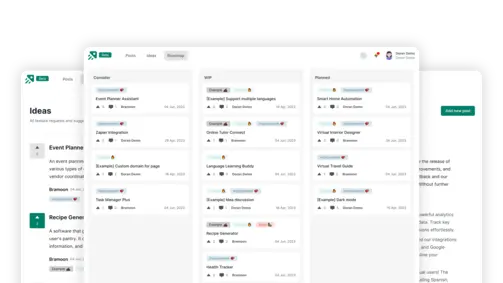CES in the Age of Automation & AI: Future-Proofing Customer Experience
Create changelog and product roadmap for your product
Explore nowTable of contents 7 min
In the ever-changing world of customer experience, the incorporation of automation and artificial intelligence (AI) has completely transformed the way businesses engage with their customers. Amidst this transformation, CSAT and CES emerge as critical metrics for evaluating the efficacy of automated and AI-driven processes. In this article, we explore the intersection of CSAT and CES in the age of automation and AI, uncovering how organizations can leverage these technologies to streamline customer interactions, minimize effort, and enhance satisfaction in the digital age.
An Exploration into the Progression of Conventional Support Metrics

Before jumping straight into CSAT and CES in the Age of Automation & AI, let’s look at the history of those metrics.
Understanding how to identify and extract the relevant information from a sea of data is crucial for top-notch support teams to consistently deliver exceptional customer service, maintain high levels of customer satisfaction, and foster a high-performing team. With the transformation of customer service by AI, support leaders must adapt their core metrics to accurately gauge success in this new era.
Leaders who wish to capitalize on the vast potential of AI must adopt a fresh perspective when it comes to metrics and KPIs.
There is a significant transformation occurring in the customer service industry due to the rapid advancement of AI technology. With the advancements in technology, support teams are now able to enhance customer interactions and quickly resolve their inquiries. This allows support teams to dedicate their time to activities that bring added value to customers.
According to the State of AI in Customer Service: 2023 Report by Intercom, there has been a significant increase in the adoption of AI for customer service. The report reveals that 69% of support leaders have expressed their intention to further invest in AI in the upcoming year.
Leaders seeking to capitalize on the vast potential of AI must adopt a fresh perspective on metrics and KPIs. This will ensure that, in a world where AI takes precedence, the genuine impact of customer service is accurately assessed. Support metrics are constantly evolving, but they will continue to be crucial for your team’s success. The integration of AI into support teams will bring about a fundamental shift in their operations. As humans and AI collaborate seamlessly, certain metrics that were once crucial for traditional support services may lose their significance. When evaluating your current reporting approach, it is important to consider both the customer and teammate experience. In order to effectively position your team for success in the modern era of customer service, it is imperative to consider both the customer and teammate experience when evaluating your current reporting approach. This will enable you to effectively monitor the key metrics that are of utmost importance.
The Rise of AI in the Customer Support metrics
It is inevitable that the advancements in AI will have a profound impact on the customer experience. Indeed, customers will enjoy the advantages of expedited and streamlined support. However, it is imperative to closely monitor this novel customer experience to guarantee their ongoing satisfaction.
CSAT in the Age of Automation & AI

Customer satisfaction, or CSAT, is a metric used to gauge the level of satisfaction among your customers. It is determined by calculating the percentage of conversations that have received positive ratings from customers, out of the total number of conversations that have been rated. CSAT surveys can vary in depth, ranging from asking customers to rate an interaction on a scale of zero to 10, to sending them direct feedback questions, or even allowing them to select the emoji that best represents their experience.
It is widely known that customers have different levels of trust in bots in general. Customers have frequently been guided through decision-tree paths that ultimately failed to provide a resolution, or trapped them in an interminable loop from which escape seemed impossible. Clearly, this is not a favorable situation for anyone. However, the latest developments in generative AI have started to instill greater confidence in customers when it comes to interacting with bots. This is primarily because these bots are capable of more efficient communication compared to their traditional counterparts, leading to the anticipation that they are more likely to provide prompt and useful responses.
Support teams prioritize monitoring customer satisfaction as they increasingly rely on AI bots. Based on the findings of Intercom’s State of AI in Customer Service: 2023 Report, a significant 58% of support leaders have reported notable enhancements in their CSAT scores by leveraging AI and automation.
Here’s a helpful tip:
It is of utmost importance for support teams to have a comprehensive understanding of the efficiency and effectiveness with which customers are receiving assistance. Understanding customer satisfaction (CSAT) is crucial in evaluating the effectiveness of your AI bot in customer conversations.
When reviewing your CSAT reports, it is important to analyze the ratings given to conversations involving the bot. Take note of whether these conversations are being rated and consider the possibility that customers may be less likely to leave ratings after interacting with bots compared to humans. This will provide you with insights into customer satisfaction regarding the interaction, the effectiveness of the bot’s support, and the ease of transferring to a team member for additional assistance. By delving further into these areas, you can enhance the bot’s performance and guarantee a consistently excellent experience for your customers.
Read more: CSAT Survey Analysis: Unveiling Insights for Improvement
CES in the Age of Automation & AI

Customer effort score (CES) measures the level of effort required for customers to have their requests processed. These tasks may involve receiving a response to an inquiry, resolving a problem, completing a purchase, or finalizing a contract. Customer satisfaction can be evaluated by conducting surveys that gauge the level of ease or difficulty customers experienced in having their needs fulfilled. This can be done by using a sliding scale ranging from “very easy” to “very difficult.”
Understanding CES in the Age of Automation & AI is crucial for supporting leaders to stay informed, as customer satisfaction, loyalty, and retention are often influenced by the ease of working with your company. In the past, customer effort score surveys were typically sent to customers at significant points in their journey, such as after a purchase or after interacting with the support team, in order to gauge the level of ease or difficulty they experienced.
In this era of AI-powered support, the objective is to further minimize customer effort across all aspects. AI bots have the ability to optimize the support process by providing quick and precise responses to help customers resolve issues and create a pleasant experience. To gain a comprehensive understanding of the CES in the Age of Automation & AI and the impact of AI on customer effort, it is crucial to assess whether customers are facing significant challenges in various aspects.
Here’s a helpful tip:
After a customer has interacted with your AI chatbot, it would be beneficial to send out a customer effort score survey. This will provide valuable insights into the ease or difficulty customers experienced in obtaining the necessary assistance. By utilizing these ratings, you can assess if your bot is effectively meeting your customers’ requirements and delivering a seamless support experience. Additionally, you can delve further into any possible areas of difficulty to identify ways of simplifying the process for them.
Read more: Customer Effort Score (CES): Definition & Ways to Measure
As we conclude our exploration into CSAT and CES in the Age of Automation & AI, it’s evident that harnessing the power of these technologies can significantly impact customer experiences. By strategically implementing automation and AI-driven solutions, businesses can reduce customer effort, improve efficiency, and ultimately drive greater satisfaction. Embrace CES as a compass for navigating the complexities of automated interactions, and leverage automation and AI to deliver seamless experiences that resonate with customers in today’s digital landscape.
What to not miss out on our blog
Gain insightful knowledge and invaluable experiences from dedicated experts.

CRM System Explained: Benefits, Types, and How It Works
Discover everything about CRM system. Learn the benefits and how a CRM system works to improve customer relationships and streamline business operations.

Are you ready? Start your free trial today.
Enhance communication, keep track of the progress, understand customers' insight and more by taking your first trial on Doran.
Sign up for free

